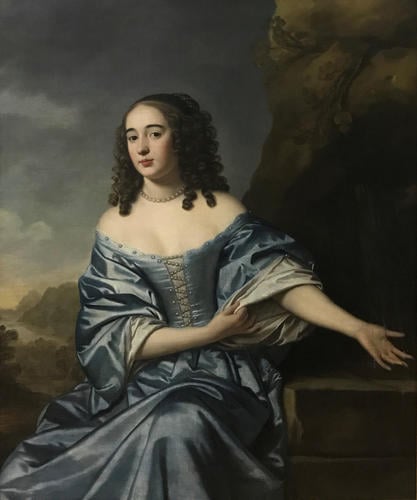-
1 of 253523 objects
Princess Sophia, later Duchess of Brunswick-Lüneburg, Electress of Hanover (1630-1714) Signed and dated 1649
Oil on canvas | 126.5 x 106.0 cm (support, canvas/panel/stretcher external) | RCIN 408700

Gerrit van Honthorst (Utrecht 1590-1656)
Princess Sophia, later Duchess of Brunswick-Lüneburg, Electress of Hanover (1630-1714) Signed and dated 1649

Gerrit van Honthorst (Utrecht 1590-1656)
Princess Sophia, later Duchess of Brunswick-Lüneburg, Electress of Hanover (1630-1714) Signed and dated 1649


-
Honthorst was a Dutch painter born and trained in Utrecht. His early career was spent in Rome, where he attained great success as a follower of Caravaggio. In 1620 he returned to Utrecht and largely abandoned religious themes in favour of Arcadian and domestic subjects and portraits. In 1628, Honthorst found success as a portraitist to Charles I and the royal family in England. He also worked for the Bohemian court, where Charles I’s sister Elizabeth Stuart was married to the ‘Winter King’, Frederick V. The sitter in this portrait, Princess Sophia, was the twelfth child of the King and Queen of Bohemia. Not only did Honthorst paint Sophia a number of times – the Royal Collection holds another of his portraits of the Princess, painted a year earlier – he was also employed as her drawing master.
Here Honthorst depicts the young Princess wearing a lustrous blue silk satin gown, sitting in a rocky landscape. Although seven other versions are known, this is likely to be the prime version, and is the only one to include a landscape in the background. The Princess is shown running her left hand under a stream of water springing from the rocks behind her, carefully holding back the sleeve of her dress. The sleeves are also pinned back with pearls, revealing white silk lining, and the bodice is scalloped to show off the sitter’s white décolletage. This costume is a perfect illustration of the manner in which artists at this date created imaginary interpretations of real clothing, influenced by the ideals of Arcadian and Antique style.
This portrait is thought to be one of the last Honthorst painted for the Bohemian court. In 1658, Princess Sophia married Ernest Augustus of Brunswick-Lüneburg, thus becoming Duchess of Brunswick-Lüneburg and later Electress of Hanover. In 1701, she was declared heir to the British throne, to which her son succeeded as George I in 1714. In her later years, Sophia was a keen patron of the arts and culture, described by a British visitor to Hanover in 1701 as ‘long admir’d by all the Learned World, as a Woman of incomparable Knowledge in Divinity, Philosophy, History and the subjects of all sorts of Books.’ The Royal Collection holds several portraits of Sophia in later life, one of which portrays her as a widow following the death of her husband in 1698.
Provenance
Purchased for the Royal Collection from Christie's, London. 19 September 2019, Lot 60
-
Creator(s)
-
Medium and techniques
Oil on canvas
Measurements
126.5 x 106.0 cm (support, canvas/panel/stretcher external)
145.5 x 123.9 x 5.0 cm (frame, external)
Category
Object type(s)
Other number(s)
CW add-Honthorst